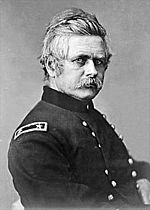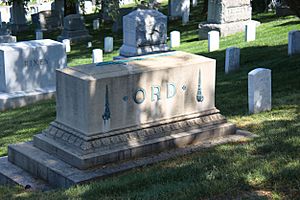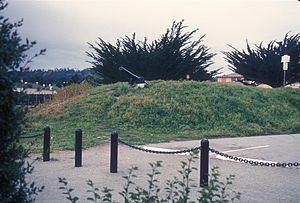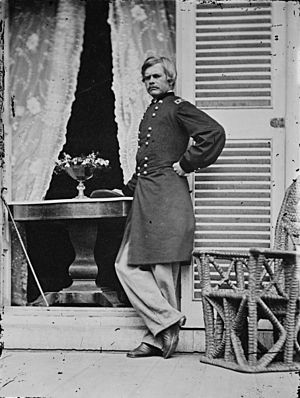Edward Ord facts for kids
Quick facts for kids
Edward Otho Cresap Ord
|
|
|---|---|
 |
|
| Born | October 18, 1818 Cumberland, Maryland, US |
| Died | July 22, 1883 (aged 64) Havana, Captaincy General of Cuba |
| Place of burial | |
| Allegiance | |
| Service/ |
|
| Years of service | 1839–1881 |
| Rank | |
| Commands held |
|
| Battles/wars | |
| Relations | Edward Otho Cresap Ord, II, son Jules Garesche Ord, son |
Edward Otho Cresap Ord (born October 18, 1818 – died July 22, 1883) was an American engineer and a brave officer in the United States Army. He fought in several important conflicts, including the Seminole War, the Indian Wars, and the American Civil War.
During the final days of the Civil War, he led an army and played a key role in getting Confederate General Robert E. Lee to surrender. Edward Ord also helped design Fort Sam Houston, an important military base. He passed away in Havana, Cuba, from yellow fever.
Contents
Early Life and Military Training
Edward Ord was born in Cumberland, Maryland. His parents were James and Rebecca Ord. Edward was known for being very good at math.
He was chosen by President Andrew Jackson to attend the United States Military Academy, also known as West Point. His roommate there was William Tecumseh Sherman, who would also become a famous general.
Edward graduated from West Point in 1839. He became a second lieutenant in the 3rd U.S. Artillery. He fought in the Second Seminole War in Florida and was later promoted to first lieutenant.
Mapping California: Gold Rush and City Planning
In 1847, Ord traveled by ship around Cape Horn to Monterey, California. This was the capital of the new territory that the U.S. had just acquired. He took command of a military unit and was ordered to finish building Fort Mervine. This fort was later renamed Fort Halleck.
When the gold rush started, prices for everything in California went way up. Military salaries weren't enough to live on. So, Ord and his friend William Tecumseh Sherman took on other jobs. In 1848, they helped survey Sacramento, California, creating the map for the city's downtown streets. Ord also made a map of the Gold and Quicksilver mining areas.
Later, officials in Los Angeles needed a map of their public lands so they could sell them. Ord was hired for this important job. He and his assistant, William Rich Hutton, mapped Los Angeles in 1849. Thanks to their work, we know a lot about what the Pueblo de Los Angeles looked like back then. Ord was paid $3,000 for his work.
Family Life and Early Career Challenges
Ord was promoted to captain in 1850 while serving in the Pacific Northwest. He married Mary Mercer Thompson in 1854, and they had thirteen children.
One of their sons, Jules Garesche Ord, was killed in action during the Spanish-American War. He was known for leading a charge up San Juan Hill in Cuba. Another son, Edward Otho Cresap Ord, II, also became an Army officer and was a painter, inventor, and poet.
In 1859, while at Fort Monroe, Virginia, Ord was called to help stop John Brown's raid on the Harpers Ferry Federal arsenal. However, Col. Robert E. Lee arrived first and handled the situation. Ord and his men were not needed.
Civil War Service: A Key Union General
When the Civil War began in April 1861, Ord was a Captain. He was soon transferred to the East and became a brigade commander. He played a role in the Battle of Dranesville in 1861.
In May 1862, Ord was promoted to major general of volunteers. He was assigned to the 2nd Division of the Army of the Tennessee. He was wounded at the Battle of Hatchie's Bridge but recovered quickly. He later took command of the XIII Corps during the final days of the Siege of Vicksburg.
After Vicksburg, Ord was transferred to the Eastern Theater in 1864. He commanded the XVIII Corps. He was seriously wounded again during an attack on Fort Harrison and returned to duty in January 1865.
The Road to Lee's Surrender
In March 1865, Ord had a conversation with Confederate General James Longstreet during a prisoner exchange. Ord suggested that Generals Lee and Grant should meet to discuss peace. Longstreet told General Lee about this idea.
Lee then wrote to Grant about a "military convention" to find a "satisfactory adjustment of the present unhappy difficulties." Grant sent Lee's proposal to President Abraham Lincoln. Lincoln told Grant to only accept a meeting if it was for the purpose of Lee's army surrendering.
This time was the peak of Ord's military career. He was given command of the Army of the James during the Appomattox Campaign. His army played a big part in the breakthrough at Petersburg. On April 9, he led a fast march to Appomattox Court House. This march helped Philip H. Sheridan's cavalry force Lee to surrender. General Sherman said that Ord's "skillful, hard march the night before was one of the chief causes of Lee's surrender."
General Ord was present at the McLean house when Lee surrendered. He is often shown in paintings of this historic event. After the surrender, Ord bought the marble-topped table where Lee had sat for $40. This table is now in the Chicago Historical Society.
After President Lincoln was assassinated in April 1865, many people wanted to punish the Southern states. General Ulysses S. Grant asked Ord to investigate if the Confederate government was involved in the assassination plot. Ord's investigation found that they were not. This helped calm the desire for revenge against the former Confederate states.
After the War: Continued Service and Legacy

During the Reconstruction period, Ord was assigned to command the Army of Occupation in Richmond. He later commanded military departments in Arkansas and California.
From 1871 to 1875, he commanded the Department of the Platte. He then commanded the Department of Texas until he retired in 1880. While in Texas, he oversaw the building of Fort Sam Houston.
In 1872, Ord joined a buffalo hunting trip in Nebraska with famous people like Philip Sheridan, George Armstrong Custer, Buffalo Bill Cody, and Wild Bill Hickok.
Ord retired from the army in 1881 as a major general. General Sherman praised him, saying he "had all the hard knocks of service, and never was on soft or fancy duty."
After retiring, Ord was hired by his old commander, U. S. Grant, to work as an engineer building a railroad line in Mexico. While working there, Ord caught yellow fever. He became very sick and died in Havana, Cuba, on July 22, 1883. He was buried at Arlington National Cemetery in Arlington, Virginia.
General Sherman spoke highly of Ord after his death, saying, "a more unselfish, manly, and patriotic person never lived."
Places Named After Edward Ord
Many places and landmarks are named in honor of Edward Ord:
- Ord Bend: A station in California was named for a ranch owned by Ord and his brothers.
- Fort Ord National Monument: A former military base in Monterey County, California, was named after him.
- Ord, Nebraska: A town in Nebraska was named in his honor.
- Mount Ord: Two peaks, one in Brewster County, Texas, and another in Maricopa County, Arizona, are named for him.
- Statue and Busts:
* There is a bronze statue of Ord at Vicksburg National Military Park. * A bust of Ord is in the foyer of the University Police Department at California State University, Monterey Bay. * Another bust of Ord is at Grant's Tomb in New York City. It shows him as one of five generals watching over Grant's tomb.
- Streets:
* There is an Ord Street in Chinatown, Los Angeles, California. * There is also an Ord Street in San Francisco. * Ord Street NE in Washington, DC, is named for him.
Images for kids




